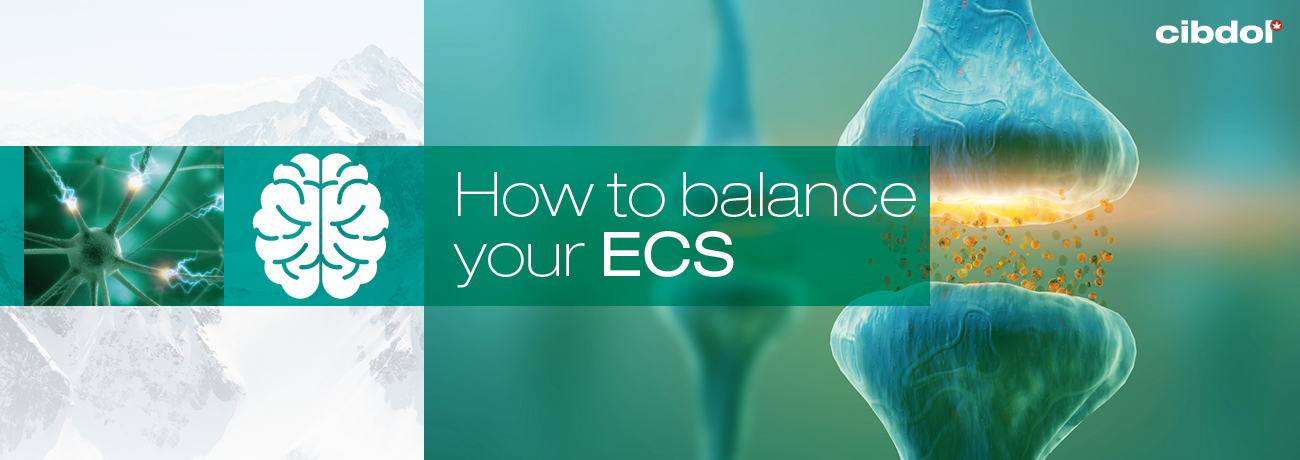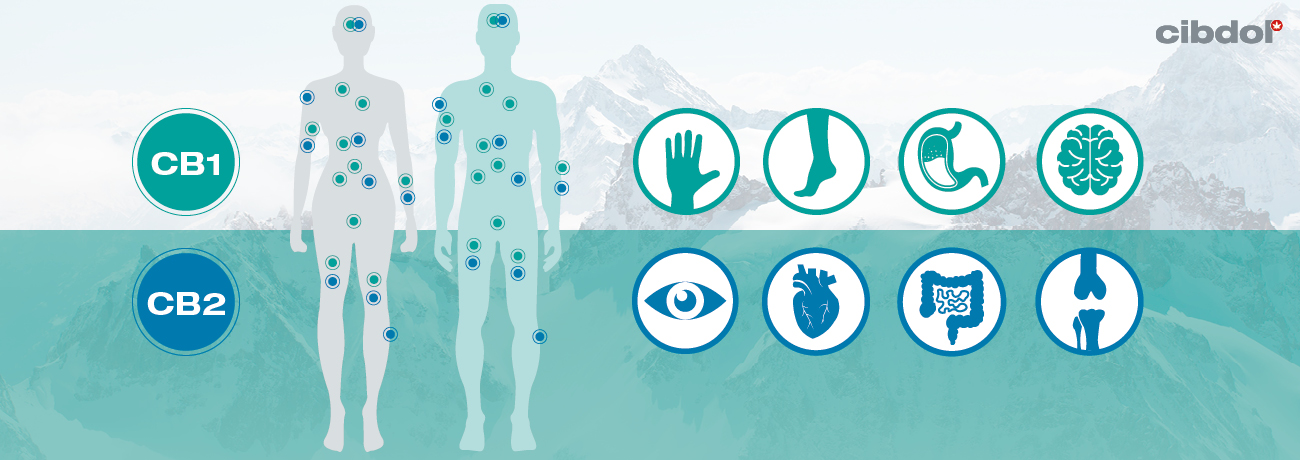How To Balance Your Endocannabinoid System

There are many things we can do to maintain the health of different bodily systems. Meditation and adequate sleep help to keep the nervous system in check; the right amount of exercise strengthens the musculoskeletal system; healthy foods and beneficial bacteria contribute to a healthy digestive system…
These strategies are common knowledge. However, we rarely consider what we can do to keep our endocannabinoid system (ECS) healthy. In fact, many people have never even heard of this important physiological network.
Continue reading to discover the importance of the endocannabinoid system and how to keep it functioning optimally.
What is the endocannabinoid system?
The endocannabinoid system is composed of receptor sites found all throughout the body. The system plays a governing role over many other biological systems, and it helps to maintain homeostasis—a state of optimal biological balance. Not exclusive to humans, the endocannabinoid system has played an important evolutionary role[1] in many creatures.
The endocannabinoid system features three main components: cannabinoid receptors, endocannabinoids, and specialised enzymes. The two main receptor types—CB1 and CB2—are found on different cell types throughout the body. They appear in the immune system, nervous system, muscles, skin, bones, brain, and even the cardiovascular system.
Internally produced endocannabinoids activate these receptor sites, specifically anandamide (AEA) and 2-AG. Cells make these molecules on demand from fat-based precursors. They act as signalling molecules and bind to their receptors much like a key fits into a lock. Both endocannabinoids play important roles in learning, sleep, bone remodelling, neuroprotection, pain signalling, and cardiac protection.
Endocannabinoid tone
As you can see, endocannabinoids play a vital role within the endocannabinoid system. They are required by the body to activate cannabinoid receptors, at the right time, to keep things in balance.
For instance, endocannabinoid signalling appears to play an important role in anxiety and depression[2]. Endocannabinoids also help to balance out the construction and deconstruction of bone[3] tissue. Because they play such an important role, the body needs to produce adequate levels of endocannabinoids.
Some health issues may arise when the body, for whatever reason, does not produce enough of these molecules—a condition known as clinical endocannabinoid deficiency[4]. Researchers have discovered a correlation between low levels of endocannabinoids and conditions such as fibromyalgia, migraine, and irritable bowel syndrome.
The same researchers state that each person possesses a certain endocannabinoid tone that reflects their levels of AEA and 2-AG. If tone decreases, it may lead to disturbances in mood, sleep, digestion, and more.
However, they also mention that excessive endocannabinoid tone might be harmful, implicating it in instances of obesity, metabolic syndrome, and hepatic fibrosis.
Cannabinoid receptor levels
The number of cannabinoid receptors that a person produces may also play an important role in human health. Just like a lack of endocannabinoids, a lack of receptors to bind to might result in similar problems.
For example, a lack of CB1 receptors appears to be associated with anxiety. Likewise, research has associated a lack of CB2 receptors[5] with increased instances of inflammation.
The number of cannabinoid receptors a person expresses may be genetically determined, however, dietary interventions may be able to alter the number of receptors to some degree.

How to balance your endocannabinoid system
To help balance the endocannabinoid system, it may be possible to consume certain foods and molecules to improve endocannabinoid tone and produce an adequate level of receptors.
However, these findings and theories derive from very early scientific research. Therefore, balancing the endocannabinoid system appears to be an area of extreme nuance. Future research will determine how to test for tone and which measures are needed to restore or establish a balanced endocannabinoid system.
For now, we do have access to research that suggests various methods of increasing endocannabinoid levels, receptor levels, and receptor activation. Continue reading to become familiar with these interventions.
Cannabinoids
Phytocannabinoids are a class of cannabinoids found in plants. They get their name from their ability to bind to cannabinoid receptors, thanks to their molecular similarity to endocannabinoids.
Cannabis provides a rich source of cannabinoids, including THC, CBD, CBN, CBG, and many others. However, other culinary herbs also produce similar molecules.
Caryophyllene—a “dietary” cannabinoid and terpene—activates CB2 receptors[6]. Both AEA and 2-AG bind to CB2 receptors[7], yet a low endocannabinoid tone might lead to insufficient activation. In these instances, caryophyllene might help to compensate for the lack of tone. The molecule exists in high quantities in the following plants:
• Black pepper
• Lemon balm
• Cloves
• Hops
• Rosemary
Alkylamides[8] found within Echinacea—an herb used in traditional medicine—also appear to target the CB2 receptor. The molecules are deemed active constituents of the plant and appear to possess immunomodulatory properties[9].
Most often sourced from hemp, users can add CBD to food and drinks. The cannabinoid doesn’t bind to cannabinoid receptors directly, but research suggests that CBD might help to temporarily enhance endocannabinoid tone by stopping specific enzymes[10] from breaking down AEA.
Fatty acids
The body makes endocannabinoids from fat-based precursors, namely omega-3 fatty acids. These molecules transform into endocannabinoids through a specialised enzymatic pathway. Once synthesised, endocannabinoids might help to keep inflammation in check[11].
This dietary source of endocannabinoid precursors also raises the possibility that a diet low in omega-3 fatty acids could lead to low endocannabinoid tone. Foods high in omega-3 fatty acids include:
• Fish
• Oysters
• Shrimp
• Seaweed and algae
• Chia seeds
• Hemp seeds
• Walnuts
In contrast, some fatty acids might decrease activity of the endocannabinoid system. Consumption of DHA may help to lower over-activation[12], possibly decreasing body fat and the risk of type 2 diabetes. Foods particularly high in DHA include:
• Clams
• Mussels
• Oysters
• Salmon
• Tuna
Aerobic exercise
Aerobic exercise might help to kick the endocannabinoid system into gear. This type of exercise involves low-intensity effort for relatively long periods of time. Think jogging, cycling, and swimming.
The body produces elevated levels of AEA[13] after aerobic exercise. Researchers think that AEA might actually be partially responsible for the so-called “runner’s high”—a feeling of euphoria that comes on after exercise.
The fact that humans evolved to run[14] suggests that the neurochemical changes associated with aerobic activity might be essential in maintaining a balanced endocannabinoid system.
[1] McPartland, J. M., Matias, I., di Marzo, V., & Glass, M. (2006). Evolutionary origins of the endocannabinoid system. Gene, 370, 64–74. https://doi.org/10.1016/j.gene.2005.11.004 [Source]
[2] Patel, S., & Hillard, C. J. (2013). Role of Endocannabinoid Signaling in Anxiety and Depression. NCBI. Published. https://www.ncbi.nlm.nih.gov/pmc/articles/PMC3808114/ [Source]
[3] Bab, I., Ofek, O., Tam, J., Rehnelt, J., & Zimmer, A. (2008). Endocannabinoids and the Regulation of Bone Metabolism. Journal of Neuroendocrinology, 20(s1), 69–74. https://doi.org/10.1111/j.1365-2826.2008.01675.x [Source]
[4] Russo, E. B. (2016a). Clinical Endocannabinoid Deficiency Reconsidered: Current Research Supports the Theory in Migraine, Fibromyalgia, Irritable Bowel, and Other Treatment-Resistant Syndromes. Cannabis and Cannabinoid Research, 1(1), 154–165. https://doi.org/10.1089/can.2016.0009 [Source]
[5] Turcotte, C., Blanchet, M., & Laviolette, M. (2016). The CB2 receptor and its role as a regulator of inflammation. NCBI. Published. https://www.ncbi.nlm.nih.gov/pmc/articles/PMC5075023/ [Source]
[6] Gertsch, J., Leonti, M., Raduner, S., Racz, I., Chen, J. Z., Xie, X. Q., Altmann, K. H., Karsak, M., & Zimmer, A. (2008). Beta-caryophyllene is a dietary cannabinoid. Proceedings of the National Academy of Sciences, 105(26), 9099–9104. https://doi.org/10.1073/pnas.0803601105 [Source]
[7] Bie, B., Wu, J., & Foss, J. F. (2019). An overview of the cannabinoid type 2 (CB2) receptor system and its therapeutic potential. NCBI. Published. https://www.ncbi.nlm.nih.gov/pmc/articles/PMC6035094/ [Source]
[8] Gertsch, J., Schoop, R., Kuenzle, U., & Suter, A. (2004). Echinacea alkylamides modulate TNF-α gene expression via cannabinoid receptor CB2 and multiple signal transduction pathways. FEBS Letters, 577(3), 563–569. https://doi.org/10.1016/j.febslet.2004.10.064 [Source]
[9] Russo, E. B. (2016a). Beyond Cannabis: Plants and the Endocannabinoid System. Trends in Pharmacological Sciences, 37(7), 594–605. https://doi.org/10.1016/j.tips.2016.04.005 [Source]
[10] Deutsch, D. G. (2016). A Personal Retrospective: Elevating Anandamide (AEA) by Targeting Fatty Acid Amide Hydrolase (FAAH) and the Fatty Acid Binding Proteins (FABPs). NCBI. Published. https://www.ncbi.nlm.nih.gov/pmc/articles/PMC5062061/ [Source]
[11] University of Illinois. (2017). Omega-3 fatty acids fight inflammation via cannabinoids. ScienceDaily. Published. https://www.sciencedaily.com/releases/2017/07/170718142909.htm [Source]
[12] Kim, J., Carlson, M. E., & Kuchel, G. A. (2015). Dietary DHA reduces downstream endocannabinoid and inflammatory gene expression and epididymal fat mass while improving aspects of glucose use in muscle in C57BL/6J mice. International Journal of Obesity. Published. https://www.nature.com/articles/ijo2015135 [Source]
[13] Fuss, J., Steinle, J., Bindila, L., Auer, M. K., Kirchherr, H., Lutz, B., & Gass, P. (2015). A runner’s high depends on cannabinoid receptors in mice. Proceedings of the National Academy of Sciences, 112(42), 13105–13108. https://doi.org/10.1073/pnas.1514996112 [Source]
[14] Bramble, D. M., & Lieberman, D. E. (2004). Endurance running and the evolution of Homo. Nature. Published. https://www.nature.com/articles/nature03052 [Source]
[1] McPartland, J. M., Matias, I., di Marzo, V., & Glass, M. (2006). Evolutionary origins of the endocannabinoid system. Gene, 370, 64–74. https://doi.org/10.1016/j.gene.2005.11.004 [Source]
[2] Patel, S., & Hillard, C. J. (2013). Role of Endocannabinoid Signaling in Anxiety and Depression. NCBI. Published. https://www.ncbi.nlm.nih.gov/pmc/articles/PMC3808114/ [Source]
[3] Bab, I., Ofek, O., Tam, J., Rehnelt, J., & Zimmer, A. (2008). Endocannabinoids and the Regulation of Bone Metabolism. Journal of Neuroendocrinology, 20(s1), 69–74. https://doi.org/10.1111/j.1365-2826.2008.01675.x [Source]
[4] Russo, E. B. (2016a). Clinical Endocannabinoid Deficiency Reconsidered: Current Research Supports the Theory in Migraine, Fibromyalgia, Irritable Bowel, and Other Treatment-Resistant Syndromes. Cannabis and Cannabinoid Research, 1(1), 154–165. https://doi.org/10.1089/can.2016.0009 [Source]
[5] Turcotte, C., Blanchet, M., & Laviolette, M. (2016). The CB2 receptor and its role as a regulator of inflammation. NCBI. Published. https://www.ncbi.nlm.nih.gov/pmc/articles/PMC5075023/ [Source]
[6] Gertsch, J., Leonti, M., Raduner, S., Racz, I., Chen, J. Z., Xie, X. Q., Altmann, K. H., Karsak, M., & Zimmer, A. (2008). Beta-caryophyllene is a dietary cannabinoid. Proceedings of the National Academy of Sciences, 105(26), 9099–9104. https://doi.org/10.1073/pnas.0803601105 [Source]
[7] Bie, B., Wu, J., & Foss, J. F. (2019). An overview of the cannabinoid type 2 (CB2) receptor system and its therapeutic potential. NCBI. Published. https://www.ncbi.nlm.nih.gov/pmc/articles/PMC6035094/ [Source]
[8] Gertsch, J., Schoop, R., Kuenzle, U., & Suter, A. (2004). Echinacea alkylamides modulate TNF-α gene expression via cannabinoid receptor CB2 and multiple signal transduction pathways. FEBS Letters, 577(3), 563–569. https://doi.org/10.1016/j.febslet.2004.10.064 [Source]
[9] Russo, E. B. (2016a). Beyond Cannabis: Plants and the Endocannabinoid System. Trends in Pharmacological Sciences, 37(7), 594–605. https://doi.org/10.1016/j.tips.2016.04.005 [Source]
[10] Deutsch, D. G. (2016). A Personal Retrospective: Elevating Anandamide (AEA) by Targeting Fatty Acid Amide Hydrolase (FAAH) and the Fatty Acid Binding Proteins (FABPs). NCBI. Published. https://www.ncbi.nlm.nih.gov/pmc/articles/PMC5062061/ [Source]
[11] University of Illinois. (2017). Omega-3 fatty acids fight inflammation via cannabinoids. ScienceDaily. Published. https://www.sciencedaily.com/releases/2017/07/170718142909.htm [Source]
[12] Kim, J., Carlson, M. E., & Kuchel, G. A. (2015). Dietary DHA reduces downstream endocannabinoid and inflammatory gene expression and epididymal fat mass while improving aspects of glucose use in muscle in C57BL/6J mice. International Journal of Obesity. Published. https://www.nature.com/articles/ijo2015135 [Source]
[13] Fuss, J., Steinle, J., Bindila, L., Auer, M. K., Kirchherr, H., Lutz, B., & Gass, P. (2015). A runner’s high depends on cannabinoid receptors in mice. Proceedings of the National Academy of Sciences, 112(42), 13105–13108. https://doi.org/10.1073/pnas.1514996112 [Source]
[14] Bramble, D. M., & Lieberman, D. E. (2004). Endurance running and the evolution of Homo. Nature. Published. https://www.nature.com/articles/nature03052 [Source]












